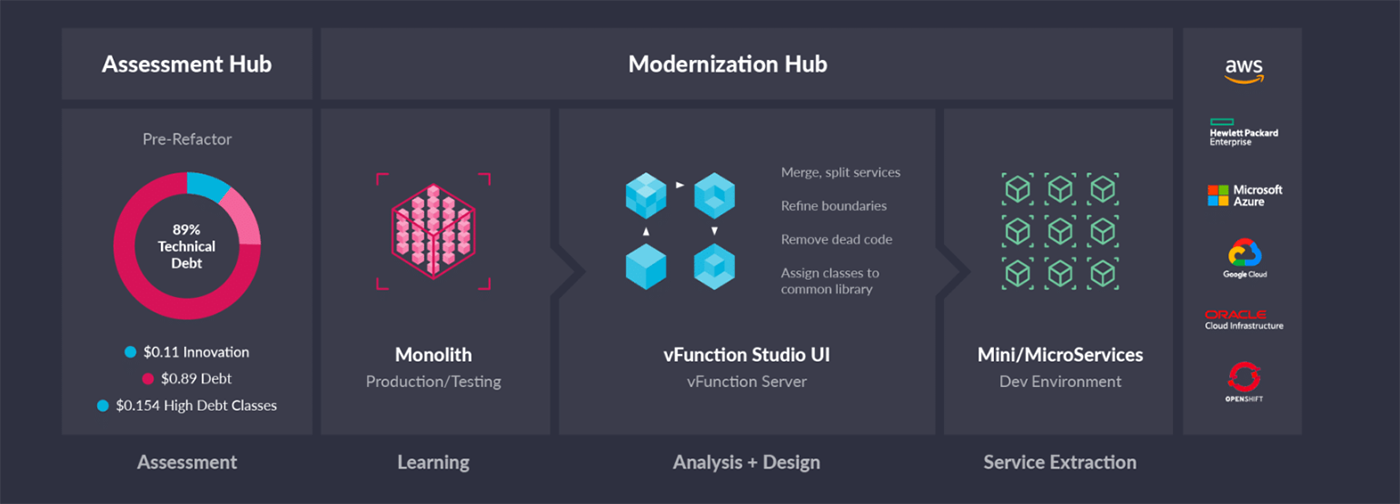vFunction Updates its AI-Driven App Modernization Platform To Tackle Technical Debt
vFunction is updating its AI-driven app modernization platform. vFunction Assessment Hub lets companies easily identity and calculate tech debt in legacy Java apps before moving them to the cloud. IDN speaks with vFunction CEO Moti Rafalin.
by Vance McCarthy
Tags: AI, app modernization, cloud-native, Java, microservices, monolith, technical debt, vFunction,

CEO & Co-Founder

"vFunction enables enterprises to prioritize app modernization efforts to restore engineering velocity, boost scalability, and gain actionable insights on the impact of technical debt."
 Modern Application Development for Digital Business Success
Modern Application Development for Digital Business SuccessvFunction is enhancing its AI-driven app modernization platform by adding automated assessment features that allow users to identify and prioritize their modernization efforts more efficiently.
The vFunction AI-driven platform delivers a scalable, repeatable factory model for modernizing on-prem Java legacy apps for cloud-native environments.
The latest platform component, vFunction Assessment Hub, uses AI to calculate the effect of technical debt across applications accurately. It aims to help companies quantify the negative impact of technical debt and measure its negative impact on innovation, vFunction CEO Moti Rafalin told IDN.
“vFunction Assessment Hub enables enterprises to prioritize app modernization efforts to restore engineering velocity, boost scalability, and gain actionable insights on the impact of technical debt,” Rafalin added. The platform also offers intelligence and automation from hundreds of legacy applications that have been analyzed and refactored by vFunction over the past 18 months.

vFunction Assessment Hub allows enterprises to accurately identify and prioritize which apps to modernize. Users can also construct an actionable roadmap for refactoring and build business case for modernization that increases innovation velocity, he added.
In specific, vFunction Assessment Hub provides several key benefits and innovations, including
- Uses AI to measure app complexity based on code modularity and dependency entanglements
- Measures the risk of changes impacting stability based on the depth and length of the dependency chains and then aggregates these to assess the overall technical debt level.
- Benchmarks debt, risk, and complexity against the organization’s estate, while identifying aging frameworks that could pose future security and licensing risks.
- Predicts the benefits of refactoring such apps before such work begins and seamlessly integrates into an automated refactoring platform.
Dealing with ‘Technical Debt is Key To Successful App Modernization
How a company deals with the ‘technical debt’ in their legacy code can determine the success of any app modernization project performs, according to Rafalin.
However, many companies find it challenging to identify technical debt within legacy code, especially when such code is 10 years old, 20 years old – or even older. After all, one company’s “tech debt” may be ‘do not touch’ code at another company.
Rafalin describes the impact of tech debt this way:
The top inhibitor to innovation velocity in organizations today is the debilitating cost and load of technical debt in large and complex applications. Current manual assessment approaches are slow, overwhelmingly complex, costly, and often fail to deliver positive business results. In order to increase innovation velocity and scalability, companies must address and eliminate accumulated technical debt across their application estate head-on.
But, understanding the actual cost of technical debt and building a business case for modernization is elusive to most enterprises today. To address this, companies need to be able to accurately assess and measure the negative impact that technical debt has on the ability to innovate, compete, and scale.
vFunction’s Assessment Hub looks to resolve this confusion by showing the level of technical debt and architectural complexity in one’s application, Rafalin said.
“Through static analysis, the report exposes how the dependencies between the classes affect the modularity of the code, the risk of impacting parts of the application, and the overall level of technical debt,” he added.
Rafalin also shared one of the best methods we’ve heard for how companies can tell the difference between “technical debt” and “valuable legacy” code.
His suggestion:
Look for symptoms of impaired value – and not just the code itself. “All symptoms of technical debt stem from code complexity and lack of modularity,” Rafalin said.
For Rafalin, top symptoms of ‘tech debt” include:
- long test and release cycles
- inability to meet business requirements in the business-required timelines
- difficulties in ramping up new developers
- poor user and customer experience and
- inability to innovate fast enough
“This level of technical debt affects the rate and cost of innovation, and is a key business measure for the application,” he told IDN.
Where vFunction’s AI Can Reliably Accelerate Legacy Modernization
Many large enterprises are finally motivated to modernize/refactor their legacy Java apps. But given the mission-criticality of these apps, companies can also be skeptical of relying on AI.
vFunction aims to increase user confidence with AI, providing observability into the code and recommendations for how to move forward. Rafalin described it this way:
What makes vFunction unique is that while it uses AI to identify the optimal entry points to the prescribed services, it is not an opinionated platform. It presents all the information in a very rich UI, that allows the architect to drill into each service, understand exactly what’s in it, refine it, see the impact of the modifications, and only then move to the last phase of automatic creation of the services based on the design.
By design, vFunction was not created as a “black box” that does some AI magic but rather uses AI to optimize decisions that the architect makes.

To go further inside vFunction’s AI approach, their three (3) high-level indicators are:
- Complexity is the degree to which class dependencies are entangled between themselves, reducing the level of modularity of the code.
- Risk is correlated to the depth and length of the dependency chains. How likely is a change in the application to affect a seemingly unrelated part of it?
- The debt is an overall calculation, taking into account complexity, risk and other factors to provide a single metric to prioritize the application for modernization.
“The average of these three metrics in the portfolio of applications is presented to further help with the prioritization,” Rafalin added.
Further, to promote AI-powered automation, vFunction delivers an end-to-end platform approach with seamless integration of its Assessment Hub and Modernization Hub platform.
So, because vFunction’s Assessment Hub integrates the vFunction Modernization Hub refactoring and modernization platform, the combination can provide users automation, actional data and recommendations to promote accurate and rapid delivery for app modernization projects.
AI and automation play a significant role here as well. “vFunction Modernization Hub automates about 90% of the decomposition of business logic into microservices, Rafalin said, adding
Unlike other tools that provide a lot of data but very little actionable information, vFunction used its learning over the past 18 months to train its [AI] models to be able to quantify the exact cost of technical debt - how much an organization is investing in technical debt and maintenance vs. innovation for every dollar invested in the application.
This metric, together with the app complexity and risk (compared to the rest of the applications in the customer’s estate) which vFunction calculates, allows the decision-maker to quickly prioritize and decide which apps are best fit for modernization.
vFunction’s Automated App Modernization Platform for Moving To Cloud-Native
The vFunction platform aims to give companies deep visibility, control and automation over Java app modernization for the cloud.
Notable components let users assess their application estate, refactor complex monoliths, and modernize lift-and-shift apps.
Assess Application Estates - vFunction provides a data-driven assessment solution that analyzes and condenses its measurements into three high-level metrics – complexity, risk, and technical debt. This lets companies prioritize and drive immediate action on modernization projects and seamlessly start refactoring on the same platform.
Refactor Complex Monoliths - For architects with one or more complex monoliths, vFunction uncovers hard to find app interdependencies and then breaks the business logic into microservices. The AI-based factory model can be used to extract just one critical service, re-architect a full monolith, or incrementally modernize your most complex megalith.
Modernize Lift-n-Shift Apps - Even after migrating to the cloud, monoliths can suffer poor scalability and limited elasticity that drive up costs, increase downtime, and result in poor customer experience. Assess how and what to modernize and then rapidly refactor to increase engineering velocity and improve application scalability.
The vFunction Assessment Hub, packaged in 10-application packs and priced below less functional automated static code analysis tools, is now available for enterprises, in the AWS Marketplace, and through vFunction partnerships with SIs and cloud providers.
Related:
- Mirantis Lens Pro Looks to Simplify Kubernetes, Boost Developer Productivity
- SentinelOne Expands DataSet Technologies for Container, Cloud-Native Security
- 2021 Was Worst Year Ever for Ransomware; Two-Thirds of Victims Paid Ransom
- OutSystems, SAP Partnership Leverages Low-Code for Novel Solutions, Migration
- Orca Security's Attack Path Analysis Improves Protection for Cloud-Naïve Apps
All rights reserved © 2024 Enterprise Integration News, Inc.


